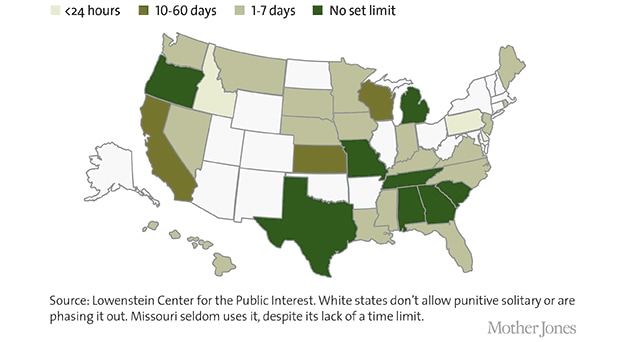Shocking Charges in Lincoln Hills Suit
Youth suffer excruciating pain, shackling, solitary confinement, ACLU suit charges.
Below are excerpts from the ACLU’s lawsuit against the state against Department of Corrections officials alleging shocking treatment of juveniles at the Lincoln Hills and Copper Lake juvenile prisons. The allegations are deeply, deeply disturbing. The state has not yet responded to them.
Lincoln Hills (LH) and Copper Lake (LH) hold 150-200 youth as young as 14 years old, according to the suit.
Excerpts
Currently, Wisconsin’s juvenile corrections officials lock up approximately 15 to 20% percent or more of the facilities’ young residents in solitary confinement cells for 22 or 23 hours per day. Many of these children are forced to spend their only free hour of time per day outside of a solitary confinement cell in handcuffs and chained to a table. Officers also repeatedly and excessively use Bear Mace and other pepper sprays against the youth, causing them excruciating pain and impairing their breathing. …
Many of these children are forced to spend their only free hour of time per day outside of a solitary confinement cell in handcuffs and chained to a table.

Source: Lowenstein Center for the Public Interest. White state don’t allow punitive solitary or are phasing it out. Missouri seldom uses it, despite its lack of a time limit.
Maximum length of punitive “room confinement” allowed in post-trial youth facilities
For another look at juvenile solitary confinement, see “This is What Happens When We Lock Children in Solitary Confinement” in the January / February issue of Mother Jones magazine.
A cell in the segregation units is approximately seven by ten feet. The cell is entered through a large metal door which swings out. The door has a small glass window about nose height and one or two slots through which food trays are passed. Youth extend their forearms through the door slot before and after being placed in the cell so that the guards may lock or unlock the handcuffs they must wear when they are out of their cells. The single window to the outside is covered with bars. …
A light in the segregation cell stays lit 24 hours per day.
A light in the segregation cell stays lit 24 hours per day. The light is dimmed from approximately 10 p.m. to 6 a.m. but is not turned off. The segregation cells are dirty and smell like sweat and urine.
Defendants often sentence youth to solitary confinement even for infractions that do not pose a serious threat to safety, such as disrespecting staff, refusing to lock into a cell, or
running.” …
Defendants often sentence youth to solitary confinement for periods of 30 or 60 days for a variety of offenses—especially when youth have been disciplined previously, or for fighting regardless of whether the altercation was likely to or did result in injury. Even when youth are charged with relatively minor rule infractions, they often spend up to 14 days in segregation while they await the issuance of a conduct report and a hearing, and then frequently get a few additional days from the hearing examiner as punishment.
The segregation cells are dirty and smell like sweat and urine.
Boys receive only a small amount of toilet paper and must request more when they need it. Boys also may not flush their toilets themselves, but must ask the guards to turn the toilet on to allow them to flush it. Because the girls’ solitary cells do not have a sink or toilet, the girls must push a call button and ask guards to be escorted to the bathroom. Guards sometimes take a long time to respond to requests to use the bathroom.
The girls must push a call button and ask guards to be escorted to the bathroom. Guards sometimes take a long time to respond to requests to use the bathroom.
Defendants also significantly limit the education youth held in solitary confinement receive. In the general population, the youth typically receive four to five hours of education Monday-Friday.
In solitary confinement, Defendants’ pattern and practice is to reduce this educational programming to a single hour outside the cell with a teacher who comes to the segregation unit and meets with about three youth at a time. During this time, they may be locked to a desk in the classroom.
In solitary confinement, Defendants’ … reduce this educational programming to a single hour outside the cell … During this time, (youth) may be locked to a desk in the classroom.
In addition, when Defendants put youth into segregation, they revoke access to the very programs which might help and rehabilitate the youth, such as Aggression Replacement Training (ART) and the Juvenile Cognitive Intervention Program (Phases I and II). If a youth misses more than a few sessions of any such program because he or she is in solitary confinement, Defendants require the youth to start the program over from the beginning.
Defendants require the youth to start the program over from the beginning.
Solitary confinement is particularly damaging to youth, who are still developing
physically, psychologically, and socially.Youth in segregation face a significant risk of serious mental harm. Solitary confinement negatively impacts juveniles by perpetuating, worsening, or precipitating mental health concerns, including but not limited to post-traumatic stress disorders, psychosis, anxiety disorders, major depression, hyper-vigilance, agitation, general lack of trust, suicidal ideation, suicidal intent, self-mutilation, and suicidal behavior.
… post-traumatic stress disorders, psychosis, anxiety disorders, major depression, hyper-vigilance, agitation, general lack of trust, suicidal ideation, suicidal intent, self-mutilation, and suicidal behavior.
The National Commission on Correctional Health Care (“NCCHC”), for example, issued a statement establishing that juveniles should not be placed in solitary confinement for any duration …
… juveniles should not be placed in solitary confinement for any duration …
The USDOJ’s Office of Juvenile Justice and Delinquency Prevention Standards for the Administration of Juvenile Justice … provide that no juvenile should be placed in room confinement for more than twenty-four hours.
…no juvenile should be placed in room confinement for more than twenty-four hours.
Gretchen Schuldt writes a blog for Wisconsin Justice Initiative, whose mission is “To improve the quality of justice in Wisconsin by educating the public about legal issues and encouraging civic engagement in and debate about the judicial system and its operation.”
More about the Lincoln Hills and Copper Lake Facilities
- Building Commission OKs Planning Funds to Reorganize Wisconsin Prisons - Sarah Lehr - Oct 29th, 2025
- State Building Commission Releases Funding Gov. Evers Requested to Revamp Corrections Facilities - Gov. Tony Evers - Oct 28th, 2025
- Gov. Evers Announces Evers Administration to Move Forward with Comprehensive Plans to Revamp Corrections Facilities - Gov. Tony Evers - Oct 14th, 2025
- For The First Time, Wisconsin’s Youth Prisons Are Fully Compliant With Required Reforms - Rich Kremer - Oct 3rd, 2025
- Inmate Sentenced For Role in Youth Counselor’s Death at Troubled Prison - Isiah Holmes - Aug 11th, 2025
- Evers’ Prison Plan Receives Mixed Reviews - WPR Staff - Feb 21st, 2025
- ‘First of its Kind in Wisconsin’ Collaboration Will Support Disabled Incarcerated Youth - Andrew Kennard - Dec 12th, 2024
- MKE County: Tight Budget Forces Difficult Vote on Housing, Juvenile Justice - Graham Kilmer - Nov 1st, 2024
- Letters from Evers, Republicans Show Clash on Juvenile Corrections - Andrew Kennard - Aug 17th, 2024
- Following Counselor Death, Staff, Family Plead for Help At Lincoln Hills - Andrew Kennard - Aug 16th, 2024
Read more about Lincoln Hills and Copper Lake Facilities here
Court Watch
-
No Unemployment Benefits For Worker Making Homophobic Remarks
 May 17th, 2022 by Gretchen Schuldt
May 17th, 2022 by Gretchen Schuldt
-
Appeals Court Upholds Injunction Against Abortion Protester
 Mar 13th, 2022 by Gretchen Schuldt
Mar 13th, 2022 by Gretchen Schuldt
-
80% of State’s Judicial Races Uncontested
 Feb 20th, 2022 by Gretchen Schuldt
Feb 20th, 2022 by Gretchen Schuldt






















